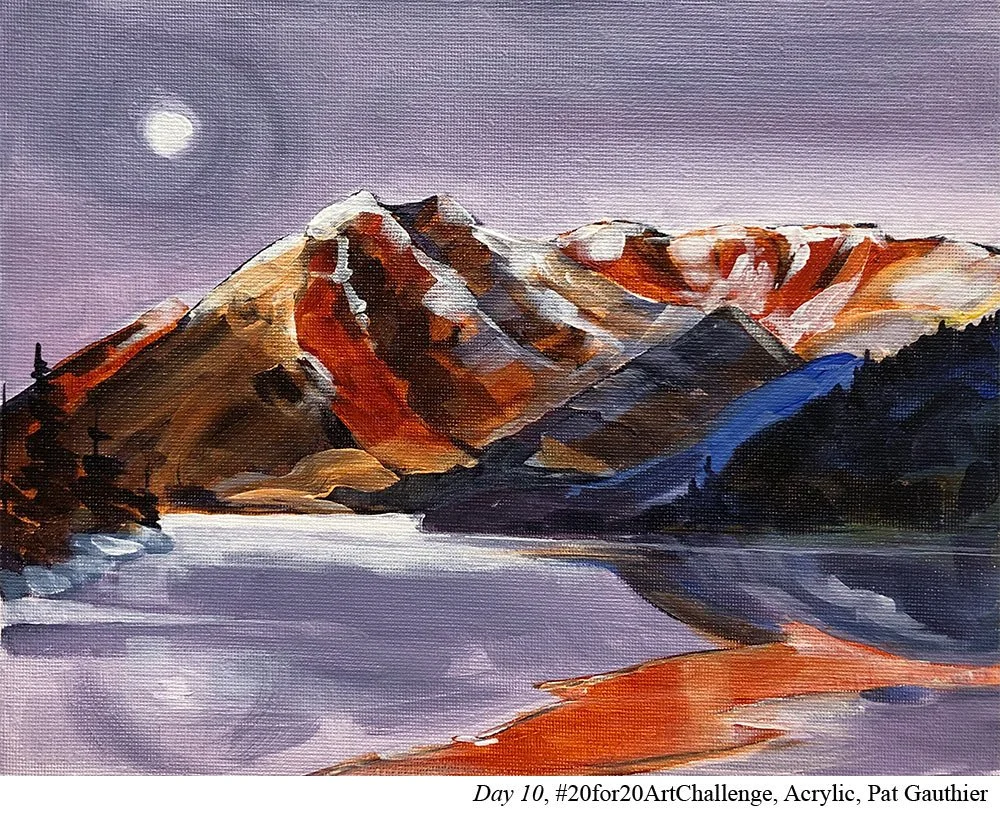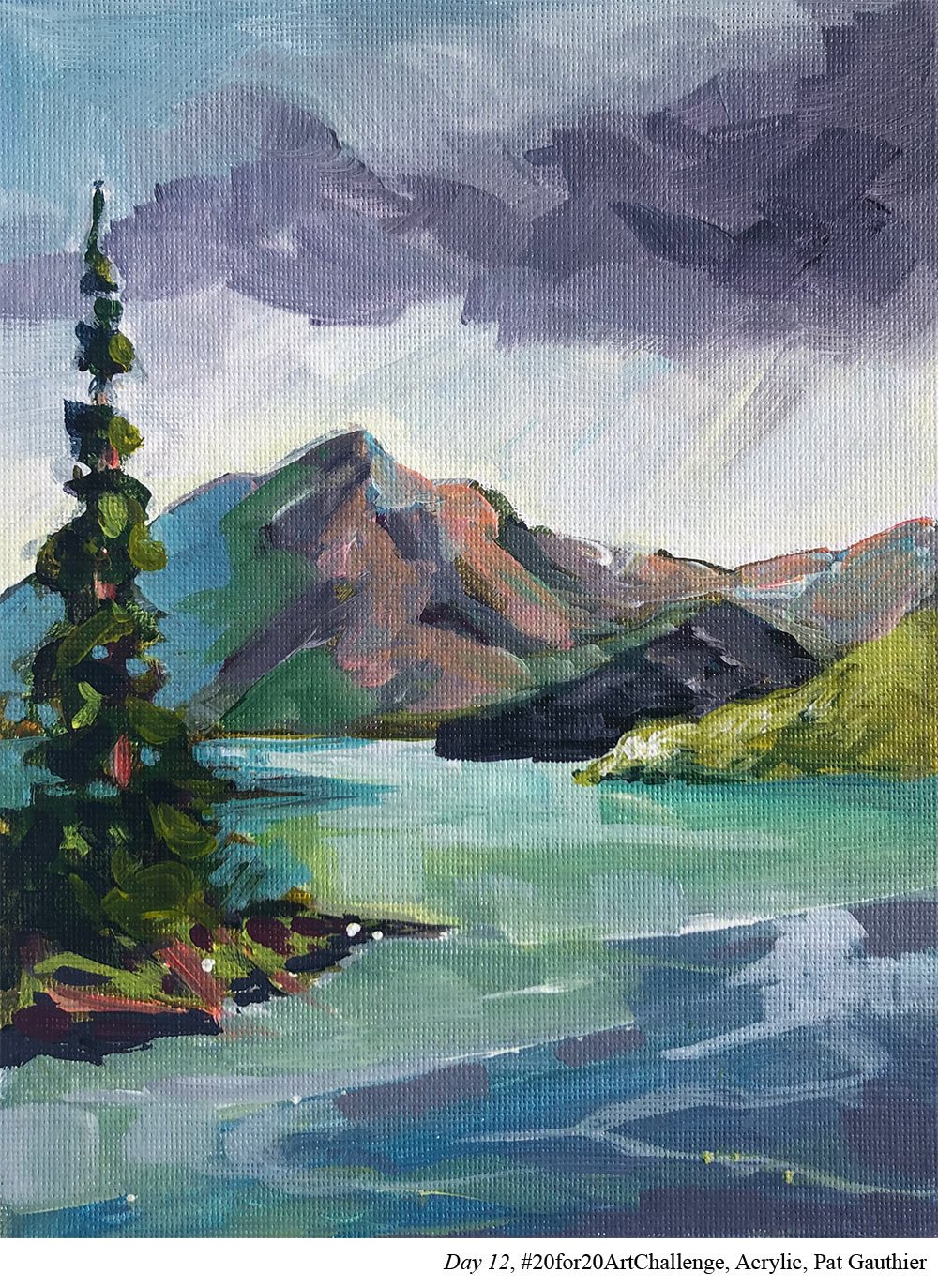#20for20 Artist Spotlight: Pat Gauthier
Artist Pat Gauthier first discovered the idea of short painting sessions from Jed Dorsey’s Acrylic University. But for the #20for20 Art Challenge she created her own spin: She’d use the same reference photo the whole time. At first this felt like a big restraint, but then it opened up more possibilities than she thought possible.
You did your daily work in about 20-40 minutes. Why did you decide to approach the Challenge that way time wise?
I’ve worked in short bursts before. I learned how to limit my time to around 30 minutes from Jed Dorsey at Acrylic University.
For the Challenge, I decided not to worry too much about time. I wanted to finished a painting each session (alla prima), but if it took a little longer that was fine.
What were the challenges but also what were the benefits of working that way?
Definitely! It was a challenge to stay within the time limit. The benefit was that I kept the paintings somewhat loose and not overworked.
What materials did you use during the Challenge?
I used Golden and Liquitex heavy-body Acrylic paint. I specifically bought an Acrylic canvas pad. I used mainly flat Princeton brushes. I also used different brushes than I normally don’t use to try different brush techniques. I decided the paintings in this Challenge weren't going to be something I would sell, it was just for study and learning purposes.
Did you limit or standardize anything?
I used a simple palette of colours including 2 warms and 2 cools of each primary plus white and black and a small amount of cadmium orange.
Everyday I worked on the same canvas pad.
This way of working helped me. I wanted all the paintings in one group or area to be able to refer back to. And by using a simple palette of colors, I was able to mix and find the colors easily.
What were your goals for your Project and how did you set that up?
My goal was to find the studio time mostly including random times whenever I could fit it in. I had all my paint and supplies set out and ready to go each day.
You worked from one reference during the Challenge, how did you decide how to approach it each day when you showed up?
For my references, I used my photos of this location. It’s a place my husband and I go camping and I’ve plein air painting that lake and mountain a fair amount. Those experiences gave me memories to source from.
So each day I would try to have a plan for the next painting a day ahead. The plans came from my morning routine.
Every morning I have tea and look at my emails and Facebook. Pinterest comes into my inbox and I love looking at my favorite artists’ paintings.
This inspiration would help me come up with ideas for how I might change the reference that day including changing the time of day, colour choices, or the direction of the light source.
What were the challenges and benefits of working this way? (With just one reference?)
For the challenges, at first, I had plenty of ideas but then after the 10th one I had some difficulty coming up with new ideas.
However the benefit was I didn’t have to come up with a different subject each day.
I think it’s important to like your reference and to feel something emotional about it. One of the biggest benefits was I didn’t stay a slave to the one reference. I could add and move it around, change format, change colors.
It took choices out of the way. It saved a lot of time not to be looking for different references.
What benefits did you find working daily even if not necessarily for a long time?
I struggle with working daily. My busy life keeps me from painting daily, and then I feel guilty and anxious about missing painting days. I now can say, I did a series and finished a personal challenge.
Any days jump out as having aha moments? Could you share what those were and why those days?
Somewhere about midway into the challenge, I realized the possibilities were almost endless. That’s when I started to really enjoy myself.
I would change the format from high horizon to low horizon.
When I toned the surfaces with different colors such as red, black, yellow, and blue, suddenly I gave the scene a different mood.
I also changed the format and the sizes, from very wide horizontal to vertical adding a vertical tree. 5x7 to 8x10 and more.
Working from a single reference really gave me permission to expand what I was willing to try.
What was the most helpful mindset for you to try and keep during the 20for20? Was there anything that was useful to remind yourself as you showed up each day? What was that and why?
I kept them on a time limit so that they stayed fresh and not overworked. And since I used a cheap canvas pad, it was easy to remember that they weren’t precious. They were just studies. But most of all, it was really useful to remind myself that this was a personal challenge first and foremost.
What advice would you give to someone doing the Challenge who finds they miss a few days? Do you think it’s still worth it to jump back in? Why?
If you miss a few days, it's okay. Do whatever you can. It’s all about practice and art time feels good no matter what.
For me, I found that even if I couldn’t paint every day, I started to develop systems.
I noticed I got pretty erratic after the 11th day. That led me to start painting more than just one painting in a session. If I could, I would paint 2 or 3 in one session.
What has been the biggest insight to you as an artist because of participating in the Challenge?
To use the same reference for all 20 was an aha moment. I hadn’t seen it done before and I’m proud to have thought it up myself. This wouldn’t have happened without the 20for20Challenge.
Learn more about artist Pat Gauthier on Instagram at Instagram.com/patgauthierart
Learn about the next #20for20ArtChallenge by adding your name to the waitlist below!







